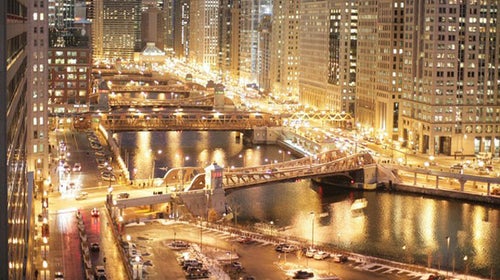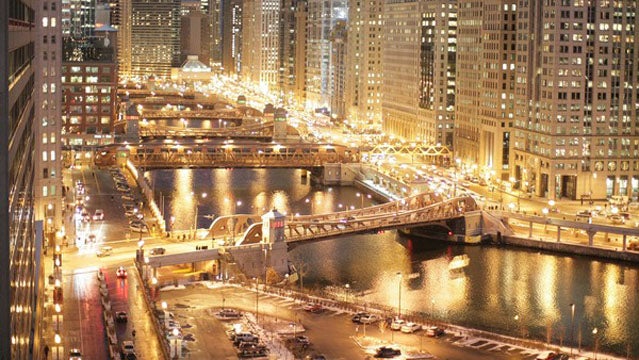This originally appeared in the Spring 2013 issue of .
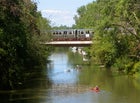 CTA train and kayakers on the North Branch, from the Wilson Avenue bridge.
CTA train and kayakers on the North Branch, from the Wilson Avenue bridge. Near the mouth of the Chicago River in 1831.
Near the mouth of the Chicago River in 1831.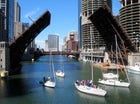 A small flotilla of boats passes through the open State Street Bridge on the Chicago River.
A small flotilla of boats passes through the open State Street Bridge on the Chicago River.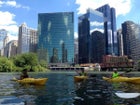 Urban Kayakers taking a break at Wolf Point.
Urban Kayakers taking a break at Wolf Point.The desolate stretch of territory alongside the South Branch of the Chicago River is littered with the shed husks of the city’s industrial past. Along overgrown banks, the rusting ribs of derelict warehouses poke out beneath crumbling storage silos. Just before South Ashland Avenue cuts across the river, there is a small spit of land where the South Branch splits—a couple of acres at most. Canal Origins Park is choked with weeds and windblown trash. Its concrete path leading to the river is lined with historical signs, now sun-bleached and obscured by a palimpsest of graffiti tags. A line of electrical pylons marches along the riverbank toward the hazy skyline of downtown, four miles distant.
Locals gather at a railing, fishing in the brown water. One angler, a retired limo driver originally from Michoacán, Mexico, chomps a cigar beneath his handlebar mustache and surveys the scene. I ask him if he ever eats fish from the river, and he just laughs. He’s a regular here, he tells me, but returned to the spot only a few days ago after having stayed away for weeks.
“The day after it rained, there was so much dead fish floating around,” he says, gesturing toward the river with his cigar. “Hundreds of ’em.” Chicago’s sewer system, overwhelmed by the heavy rainstorm, had overflowed again. He points to the concrete drainpipes that had disgorged tens of thousands of gallons of untreated waste and pollutants into the river. “They tested the water, said it was safe,” he says. “Maybe it was. I left, and I didn’t come back. It was horrible—the smell.”
It’s been a troubled stretch of water for a long time. Made infamous in Upton Sinclair’s 1906 novel, The Jungle, the south fork of the South Branch served as the gutter for the vast Union Stock Yards, at one time the world’s largest meat producer, where several hundred million head of livestock were processed in the century after the Civil War. As Sinclair vividly described it, the creek was so clogged with grease and offal that people would mistake it for solid ground and fall in. Sometimes the surface would catch fire. Bubbles of methane would periodically rise up from the depths and burst, giving it its nickname, Bubbly Creek.
A shout goes up at the rail as a second fisherman struggles with his bent-double rod. (“Might’ve got one!” he yells out to his friends, before adding the requisite punch line: “But it’s got three eyes!”) When he finally hauls his catch onto the bank, it is revealed to be not a fish at all, but rather a large (and angry) red-eared slider turtle. A group gathers around as he frantically tries to remove the hook without losing a finger to the turtle’s snapping beak. Eventually the hook is freed, and everyone steps back as the dripping creature scuttles to the edge and launches itself over, splashing down and vanishing beneath the murky water.
The turtle is a strange visitor in such a profoundly altered landscape, one where the natural world seems buried beneath a sedimentary burden of human detritus. But as unloved and forgotten as this little river junction appears, it has been as central to Chicago’s history as the skyscrapers piled up theatrically in the distance. It’s hard to ascribe majesty to such a dirty, ruin-crowded waterway, a rill so narrow it can be easily spanned by a well-thrown baseball. But it would be even harder to overstate this river’s importance to both the past and future of its city. Chicago—and America along with it—grew up around this river. A burgeoning nation’s commerce, sweeping migrations of humanity, colossal feats of engineering and architecture: all combined on either side of its banks to form the “stormy, husky, brawling, City of the Big Shoulders” that Carl Sandburg invoked in his great poem “Chicago.”
More than a century ago in this exact spot, human ingenuity shaped nature to its will, smashing through the earthen barrier that separated the Mississippi River drainage area from the vast freshwater reservoir of the Great Lakes, stitching together the commercial energies and distinct ecosystems of the North American continent. The consequences of that decision are still playing out today in a metropolis where more than seven million people draw their drinking water from Lake Michigan—and where those same people pump their sewage back into the river. Myriad threats, from water pollution to flooding and invasive species, have made the question of what to do about the Chicago River one of the most important questions facing the city. And simply by asking it, Chicagoans are acknowledging a basic existential struggle.
That struggle is between two competing visions. One is remedial and pragmatic, the province of engineers and bureaucrats. In their eyes, the river can and should be cleaned up only to the point where it can operate as a safe, functional waterway that exists to meet the demands placed on it by commerce, flood control, and the dispersal of wastewater.
In the alternate vision, however, the river meets all of these demands—and more. Its proponents seek nothing less than to turn the Chicago River into a civic treasure, its newly cleaned banks lined with parks and homes and restored ecosystems, its very presence a clear and shimmering symbol of a great city built on making, trading, connecting: a symbol of American history’s inexorable flow toward progress. And in the bargain, they seek to make the river a living—and flourishing—example of environmental innovation and ecological stewardship, one that generations of Chicagoans will cherish.
THE LANDSCAPE OF PRESENT-day Chicago was formed by the retreat of the Wisconsin glacier some 14,000 years ago, which resulted in a flat and marshy plain at the southern end of the enormous Great Lakes basin. The area was settled by Algonquian tribes, who called the slow and sinuous creek flowing into Lake Michigan shikaakwa, after the wild leeks that grew on its banks. When the French explorers Marquette and Jolliet canoed up the Mississippi and Illinois rivers in 1673, native guides showed them a portage—a few miles of swampy land that required the dragging of boats across a mud flat—linking the Great Lakes via the Chicago River to the Mississippi River system beyond. And so did a leech-infested marsh become one of the most strategic transit points in all of North America: a key to the continent.
From this stroke of great geographical good fortune, Chicago evolved as a center of commerce and a key transportation hub, Sandburg’s “Player with Railroads and the Nation’s Freight Handler.” In 1848 a canal was dug to formalize the connection between the Chicago River and the lake, and railroads started pinwheeling out from the young city’s center. By the turn of the century, Chicago had grown an astonishing fiftyfold, to 1.7 million people, making it the fifth-largest city in the world. Its breakneck population growth put enormous strain on the river that cut through the city’s center and emptied into the lake, the source of its drinking water. The river flooded frequently and had become hideously polluted: outbreaks of dysentery, typhoid, and cholera throughout the 19th century led to fears of a city-destroying epidemic.
The water had to be managed in some way. A municipal agency called the Sanitary District of Chicago had been formed in 1889 to address wastewater and flooding issues for the rapidly expanding city. The idea seized upon by the political bosses was devilishly simple: reverse the Chicago River. By digging a long canal to connect it to the neighboring Des Plaines River, the agency could divert the flow and effectively flush the city’s waste downstream—and ultimately into the Mississippi—thus protecting Chicago’s drinking supply, controlling flooding, and opening up a much faster transportation route. Their solution, the Chicago Sanitary and Ship Canal, was 160 feet wide, 9 feet deep, and 30 miles long, much of it carved through solid limestone. At the time of its completion, in 1900, it was hailed as a visionary feat of engineering, one that would wash Chicago’s troubles away and bear the city into a healthy and prosperous new future.
ONE OF THE CHIEF logistical hurdles Chicago has faced is how to deal with its wastewater from sewage, storms, and flooding. Because of the city’s marshy location, flooding was a problem from its inception; in 1855 the city council ordered that downtown Chicago be elevated to accommodate a new drainage system. Armies of men working in tandem literally jacked up buildings, streets, and sidewalks by as much as 14 feet.
But the city’s water problems have persisted to the present day. In July 2011, a single storm dropped nearly seven inches of rain overnight; thousands of basements were flooded, and municipal sewers containing both storm runoff and raw sewage overflowed into the Chicago River. To prevent the river from leaping its banks, the locks into Lake Michigan were opened, and millions of gallons of sewage flowed out into the lake. Such floods and sewer overflows have become increasingly common, with untreated human waste gushing into the river after nearly every heavy rain.
To deal with the problem, Chicago’s water agency in 1972 launched one of the largest civil engineering projects in history. It was officially known as the Tunnel and Reservoir Plan (TARP), but was popularly known as the Deep Tunnel, a massive system which, its champions claimed, would be able to absorb runoff from even the most severe storms. More than a hundred miles of tunnels were dug through layers of bedrock, some as deep as 300 feet belowground, creating a subterranean complex with the capacity to store more than two billion gallons of wastewater. New reservoirs, the other half of the plan, would be able to hold billions more. Forty-one years and several billions of dollars later, completion of the Deep Tunnel is currently slated for 2029.
To get a sense of what the city has to deal with, I drive out to the Mainstream Pumping Station, alongside the Chicago Sanitary and Ship Canal, 15 miles west of downtown. Passing through the enormous circular gate at the facility’s entrance gives me a sense of the Deep Tunnel’s scale: at 32 feet in diameter, it’s the same size as some of the underground pipes that carry Chicago’s waste here. This is one of three such stations in a system that serves more than 10 million people, the vast majority of whom are unaware of its existence.
With Henry Marks, a cheerful, bearded engineer, I ride an elevator 30 stories down into the earth, eventually stepping out into a brightly lit chamber as large as two indoor basketball courts. Pumps whir and hum as they push Chicago’s sewage from tunnels back to the surface, where it will be treated. A giant steel screen in the pumping system catches the larger hunks of urban detritus that might jam or damage the pumps. (Marks has plenty of stories about all kinds of oddities that have been stopped by the screen: car hoods, railroad ties, bowling balls, even snowblowers.) The pressures, both literal and figurative, are enormous. If one of these pumps were to blow, the entire station would fill up to ground level with raw sewage.
The Deep Tunnel must be constantly monitored; it must also be emptied out as much as possible before intense rains to free up space. The entire system can process 2.6 billion gallons a day, although when TARP is eventually completed, its capacity will be 17.5 billion gallons. Marks has worked for the Metropolitan Water Reclamation District (MWRD)—as the Sanitary District of Chicago came to be known in 1989—for 27 years. I ask him if this increase in capacity will be enough to eliminate regular discharges into the river. “We hope!” he says, chuckling sheepishly.
From Mainstream the city’s sewage is pumped to the Stickney Water Reclamation Plant, six miles away. Stickney is the largest wastewater treatment facility in the world; it sprawls across 414 acres and processes 750 million gallons of waste a day. Sewage is first pumped to scores of circular settling tanks, where solids are separated, and then to aerated digester troughs, where aerobic bacteria break down the waste. When I visit, there is no smell whatsoever in the air, just the bubbling sound of trillions of microbes, happily at their labor.
After treatment, the water is pumped back into the canal and eventually flows down to the Gulf of Mexico. Unlike every other major city in the United States, however, Chicago doesn’t currently disinfect its wastewater, a process that typically involves UV radiation or chlorination. Levels of E. coli bacteria in non-disinfected wastewater sent from Stickney into the canal have registered 700 times above the legal limit for swimmable water. After years of legal pressure from groups including the Natural Resources Defense Council (which publishes OnEarth), the MWRD in 2010 finally agreed to begin disinfecting its wastewater by 2015.
After leaving Stickney I drive past miles of sludge-drying lagoons to the site of the McCook reservoir: the long-delayed final stage of the Deep Tunnel project. From its edge I peer down at what appear to be, from a height of 300 feet, toy-size dump trucks loading quarried rock that will be sold as construction aggregate. When MWRD negotiated the digging of the reservoir, the excavation schedule was set according to the market vicissitudes of the construction industry. TARP’s giant hole, it was agreed, would be dug only as fast as its excavated rock could be sold off. If market demand slowed (as it did, dramatically, during the latest recession), the pace of the digging would slow correspondingly. At current projections, the reservoir’s promised capacity of 10 billion gallons will not be reached until at least 2029. If that goal is met — which is anything but certain—it will have taken nearly 60 years to complete.
MEANWHILE, AS THIS GLACIALLY paced drama unfolds, a specter haunts the dreams of Chicago’s water managers in the form of a silvery, flashing mass of , swarming north along the Mississippi system toward the Great Lakes. Originally imported to the United States in the 1960s to eat the algae that were clogging commercial fish farms, the carp may have entered the Mississippi River system as early as the 1970s. The fish reproduce rapidly and are voracious eaters that can grow to be 110 pounds, outcompeting many native fish species.
The sport and commercial fishing industry in the Great Lakes is worth an estimated $7 billion annually, making it one of the most valuable freshwater fisheries on Earth. Were Asian carp to establish themselves in the lakes, the fish would be nearly impossible to eradicate and would likely lead to ecological and economic catastrophe in many sensitive areas. “They could destroy the ecosystem by, quite literally, devouring a great deal of it,” says , a senior policy analyst with NRDC. The carp, she notes, are filter feeders, “meaning they don’t seek their prey but rather open their mouths and simply take in whatever passes by.”
Since the Chicago Ship and Sanitary Canal is seen as the carp’s most likely route to the Great Lakes, it is, appropriately, where one of the most concerted governmental efforts to stem the carp’s advance is taking place. One approach that has received considerable support from scientists, environmental advocates, and lawmakers was laid out in a 2012 report by the Great Lakes Commission, an international agency formed by the U.S. states and Canadian provinces that border the lakes. Its report advocated the “hydrologic separation” of the Mississippi and Great Lakes ecosystems. It’s a wonky way of describing a dramatic step: restoring the physical barrier between the two ecosystems, in a process that could eventually lead to a restoration of the Chicago River’s original flow—away from the Mississippi watershed and back into Lake Michigan.
Separation is a highly controversial proposition. It has been decried by Chicago’s politically connected shipping industry as a job killer. Others raise fears that without the canal as an outlet for Chicago’s stormwater, the city is but one good flood away from devastation. Mainly, however, opponents simply say that the costs would be prohibitive. But whatever the costs of physical separation, many think that it would be effective at keeping the carp out of Lake Michigan—far more effective than the series of electric barriers that the U.S. Army Corps of Engineers currently operates in the canal, which malfunction from time to time.
“It’s a no-brainer that a physical barrier is going to be more effective than any other kind,” says David Lodge, director of the University of Notre Dame’s Environmental Change Initiative. “But that’s different from saying that’s what should be done.” Lodge sees his role as educating people about long-term risks and rewards, and then leaving the public and policy makers to decide. One of the difficulties he faces is getting all parties to think in terms of a longer time frame, rather than an immediate cost-benefit analysis. “What’s the likely future cost if we don’t do anything?” he asks. “What’s the cost of the status quo?”
A VAST ARRAY OF possibilities arises from that very question. In decades of raging debates over the fate of the Chicago River, perhaps no organization has been more emblematic of the status quo, and the frustrations borne of Chicago-style politics, than the Metropolitan Water Reclamation District.
David St. Pierre, the MWRD’s new executive director, has an unenviable job. It’s certainly not easy overseeing such a vast system, what with perpetually squeezed budgets and hell to pay whenever people’s basements flood or the city’s lakefront is shut down by a sewage outflow. The two most extreme rain events in the city’s history have occurred in the past five years. Meanwhile, as he ponders the ramifications of that particular fact, he has many different constituencies to satisfy: government, business, environmental advocates, and the general public.
St. Pierre says he wants “to look at problems in a holistic sense,” placing everyone’s competing needs on an equal footing. Toward this end, he’s more than willing to have an open dialogue about the most pressing issues facing the river—even the hugely complicated prospect of separation and reversal. The fact that he’s willing to talk about these ideas at all represents a significant step forward for the MWRD. The agency has long been seen as averse to any form of outside interference. (It resisted disinfection of its outgoing treated wastewater for decades, for example, with one member arguing that disinfecting water that reentered the river would only encourage people to swim, and lead to more drownings.)
All the same, St. Pierre says he could support a separation scheme so long as it met or exceeded current water-quality levels and flood-control capacity. In person he comes across as both open-minded and skeptical; he understands all the arguments for separation and appreciates the alternatives the Great Lakes Commission and others have put forth. But when it comes to discussing their chances of success, he’s as blunt as an alderman up against the wall at a raucous town hall meeting. “All of them are cost-prohibitive,” he says. “Nobody has that kind of money right now.”
But cost isn’t the issue, says , the former (and founding) Commissioner of Environment for the city of Chicago and now the director of . “They should comply with the law,” he says. Arguments about whether or not this or that particular solution makes economic sense can’t be allowed to become “the escape hatch for complying with water quality standards.” Henderson sees such rationalization as betraying a deeper problem within the organization. “Their resistance is cultural; they do not want to be told what to do. MWRD is historically a very insular operation, and they don’t like external direction.”
The excuse that a crucial initiative may be worth doing—but that the money, alas, simply isn’t there—is as old as politics itself. But it forces one to ask questions along the lines of Lodge’s and Henderson’s. Shouldn’t short-term economic concerns be balanced against, say, compliance with the Clean Water Act? Against the need to do right by the future citizens of Chicago? Perhaps the most troubling implication of MWRD’s inertia, of course, is the suggestion that the agency has always privately viewed the river, first and foremost, as a sewer—and that any other value or imaginative possibilities it might hold come in a distant second.
There are, however, promising signs that the agency’s ossified culture may be shifting. More than any of his predecessors, St. Pierre seems open to progressive ideas. It’s just that his job requires wrapping his mind around billion-gallon (and billion-dollar) units. He says, for example, that he’d like to see a workable plan for creating 2,000 gallons of green infrastructure storage for every home—an advance, he believes, that would be large and noteworthy enough to have a real impact and create a true sense of shared stakes and responsibility. Something like that, he believes, would force Chicagoans to identify the river’s sad state as “a community problem.” And people have to start thinking in those terms, he says, “if you’re going to change the culture.”
AS IT HAPPENS, THERE are plenty of people within the larger Chicago community who are already thinking in these terms. One group working to “change the culture” is , an advocacy organization founded in 1979. John Quail, its director of watershed planning, understands well the political challenges and bureaucratic inertia that have always stood in the way of real change. But, he tells me, in recent years Chicago’s mayors have come to realize that “the river is an asset for economic development and recreational development.” He has seen real progress, accompanied by some powerful visual symbols: an otter was spotted swimming in the main stem of the river not long ago, the first such sighting in generations. But, Quail says, “You’ve got to make the water improvements and the habitat improvements at the same time. Because if you’re releasing sewage into the river 200 times a year while you’re putting condos or restaurants on it, or having people paddle on it, that’s not a sustainable situation.”
Perhaps the most high-profile local figure engaged in the task of reimagining the Chicago River is the . Gang is a MacArthur Fellow who has designed stunningly innovative buildings for cities all over the world. Her Aqua skyscraper, completed in 2010, rises 859 feet above Chicago, its wavelike facade a gorgeously undulating contrast to its modernist and art deco neighbors.
I meet Gang one day at her office, where a team of architects bustles around us. She shows me her proposed redesign for Northerly Island, on Chicago’s lakefront: a park featuring a seamlessly integrated marina, amphitheater, and range of wildlife habitats from woodland to lagoon to reef, all built on the site of a former municipal airport. This blurring of the divisions between human uses and the forms and functions of the natural world is a signature of Gang’s design work, and has led to her ongoing creative engagement with the possibilities for redeeming the Chicago River.
Intrigued by a on the need for hydrologic separation, Gang embarked on a yearlong project that turned the idea into the basis of a classroom exercise for her students at Harvard’s Graduate School of Design. She encouraged them to think broadly, to engage not just the physical challenges of the site but also the social, cultural, economic, and educational possibilities.
One student’s project sought to incorporate the now-derelict Fisk coal plant into a barrier: wastewater from the canal would pass through a series of “vertical wetlands” within the soaring volume of the building’s huge turbine hall, which would be further repurposed into a public water-education center. Another student imagined a barrier that doubled as a pedestrian bridge connecting two neighborhoods, Pilsen and Bridgeport, separated by the canal. It would be yet another meaningful symbol: two historic Chicago communities being brought together at the same time that a natural division was being restored.
A third proposal entailed building a network of neighborhood-scale wetlands on disused tracts across the city; together they would form a natural buffer, absorbing wastewater and runoff before they reached the river. It’s an example of green infrastructure on a scale both epic and intimate (and one that’s not so far off from what David St. Pierre has said he’d like to see). Still another student looked at ways of incorporating green technology into the riverfront’s many abandoned industrial spaces. “A power grid, a fish farm—new industry to replace the lost industry,” Gang says. Encroaching Asian carp, she adds, could even be harvested for processing into biofuel or fertilizer.
I ask Gang if these aren’t just pipe dreams, impossible to get past Chicago’s political gatekeepers or a skeptical public. “Nothing gets you more involved with politics than having your basement flood,” she says. The key, she believes, is to break what may seem like an impossibly large project into discrete, manageable efforts: “It’s not an easy time to get anything to happen. But you can incentivize things to happen on a more dispersed, networked scale—things like building green infrastructure.” It occurs to me that what she’s describing is a kind of utopian incrementalism: a poetic inversion of the frustrating slowness the city brings to its own progress on huge projects like TARP.
The question must be asked: Why ����dzܱ����’t Chicago reimagine itself in a big way? After all, it has done so several times. When it was literally elevated to a higher grade, back in the 1850s. After the great fire of 1871, when it arose, phoenix-like, to become the first modern city, erecting the first skyscraper in 1885. And, of course, in 1900, when it reversed the flow of the Chicago River. Now, it would seem, is the time to conjure those same spirits of optimism and daring and to put all of Chicago’s Big Shoulders—and big minds—to work once more. It begins with Chicagoans’ deciding what it is they really want, and having the audacity to say that they deserve it. And then, says Gang, “you just work backward. It’s step by step.”
ON A PERFECT, BLUE-sky summer morning, I take the El to the North/Clybourn stop and walk to the boat launch by Goose Island. I rent a kayak, strap on a life jacket, and slip the boat into the water. Mallards bob along the shoreline, and a panorama of the city spools out before me. Every hundred yards or so, a concrete sewer pipe pokes out into the river like the entrance to a sea cave. Newly built condominiums and retrofitted warehouse buildings line the banks in many places. The river, long ignored (except when it’s dyed green on St. Patrick’s Day), has recently become something of a magnet for development—recognized finally for its aesthetic value, at least: the view of it, from a high apartment window, is considered an amenity.
Turning east into the main stem, I dodge ferry traffic as I paddle beneath a series of bridges. Tourists peer down at me. The scene is astonishingly beautiful. Many of the iconic works of 19th- and 20th-century architecture rise above the river: the Wrigley Building, the Tribune Tower, the Sears tower. Even the Trump International Hotel has a glittering phallic majesty to it.
Does it really require a crisis—floods, pollution, an invasion of carp—to make meaningful change happen? When he served as President Obama’s chief of staff, Chicago mayor Rahm Emanuel was fond of instructing his staff to “never allow a crisis to go to waste.” One wonders if he’ll take his own advice when it comes to the Chicago River. In his iconic poem, Carl Sandburg spoke of a young city laughing “under the terrible burden of destiny.” That historical burden—that sense of a city grasping toward the limits of what is possible—still seems manifest.
As I pass under Lake Shore Drive, there is only one lock separating me, and the Chicago River, from the deep blue, oceanic expanse of Lake Michigan. I spin around in the slow current and look back down the river as it slips through the monuments of human ingenuity. If all this was made, it occurs to me, it can be made right.
